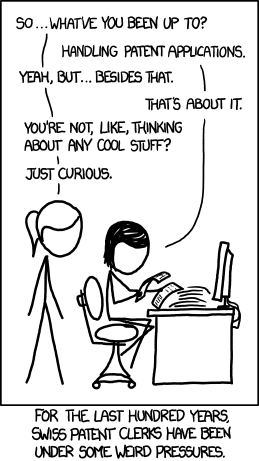 Greg Aharonian has said for many years that the patent system is bust. If it weren’t how could there possibly be tens of thousands of software patents given that so many of them are simply variations on the spreadsheet, word processor, file compression, and image editing? I followed Aharonian’s patent news service from around 1994-5 for several years and several times gave him a mention in the Feedback section of New Scientist when he published a particularly poignant item. I’ve not really kept anything more than a weather eye on patents and the broader area of intellectual property, although I have covered specific aspects during my almost quarter century in science communication.
Greg Aharonian has said for many years that the patent system is bust. If it weren’t how could there possibly be tens of thousands of software patents given that so many of them are simply variations on the spreadsheet, word processor, file compression, and image editing? I followed Aharonian’s patent news service from around 1994-5 for several years and several times gave him a mention in the Feedback section of New Scientist when he published a particularly poignant item. I’ve not really kept anything more than a weather eye on patents and the broader area of intellectual property, although I have covered specific aspects during my almost quarter century in science communication.
Patents and IP expert Robert Pitkethly of Oxford University, UK, argues how IP systems depend on awareness of intellectual property but has found through a large-scale survey of UK industry that while larger companies are more IP aware, SMEs (small to medium-sized enterprises) and the vast numbers of “micro” enterprises are often wholly unaware of the IP system. He suggests that the IP system is the driver of innovation and that it underpins the growth of those micro and SMEs. An understanding and awareness of patents, copyright, trademarks, registered designs, the need for confidentiality, and other factors are thus vital particular at the start-up phase.
“Enabling SMEs and micro-enterprises to use their IP to grow into larger companies which are successful not just locally but internationally, is thus an essential role of IP awareness promotion,” Pitkethly explains in the journal IJTM. He adds that it is not only important that small firms are made aware of the various IP systems, but that improving awareness feeds back into the system itself underpinning its relevance. Of course, the “open” movement whether in science, innovation, or any other area might argue that IP concerns actually stifle innovation. It is nevertheless difficult to see what incentive there would be for a smaller company to develop its inventions, whether pharmaceuticals or vacuum cleaners if there were no protection of their designs to allow them to recoup their costs, make a profit and re-invest in their business to come up with the next invention.
![]() Robert H. Pitkethly (2012). Intellectual property awareness Int. J. Technology Management, 59 (3/4), 163-179
Robert H. Pitkethly (2012). Intellectual property awareness Int. J. Technology Management, 59 (3/4), 163-179